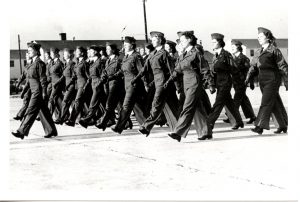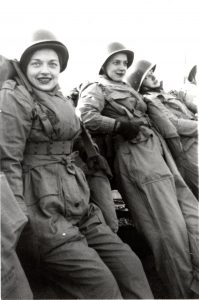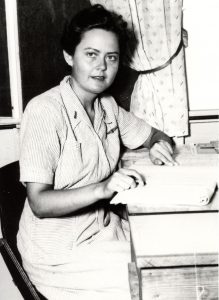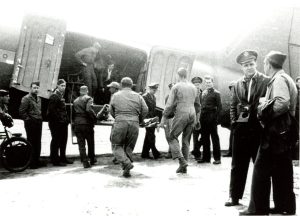Personal Reflections on Coping with War
Part 5 When Health and Hygiene Were a Concern
For the 25 flight nurses interviewed for Beyond the Call of Duty: Army Flight Nursing in World War II, wartime service was beset with potentially difficult circumstances that could exact a toll on even the most hardy of nurses. To cope with these professional and personal challenges, these women drew on many sources of support, tangible and intangible, physical and mental. Social support, one’s physical condition, and abilities and skills fostered in nurses’ training all helped the flight nurses cope behaviorally with the multiple demands of the war. Reasonable expectations, devotion to duty, an optimistic outlook, and faith in one’s God, one’s colleagues, and one’s self all helped them cope emotionally with the war.
The often primitive conditions in which flight nurses lived and worked, as well as the demands of air evacuation duty, required a great deal of physical stamina.
Physical fitness was a positive outcome of the flight nurse training. Lee Holtz, a flight nurse with the 801 Medical Air Evacuation Squadron (MAES) in the Pacific recalled that physical training had been rugged, but it paid off when her squadron got to the jungle, where they needed to be in top physical shape. Denny Nagle, assigned to England with the 815 MAES, also found the physical training “really rough, but I never felt better in my life [than] when we finished … all that exercise.”
 Flight Nurses on Parade, Bowman Field, KY [USAF Photo]
Flight Nurses on Parade, Bowman Field, KY [USAF Photo]
Keeping busy was important to surviving the rigors of wartime service. When on transatlantic flights, Jenny Boyle, assigned with the 816 MAES in England, was surprised “how much time you can spend without doing anything spectacular, just by being there and helping out and talking with the patients, but you stayed busy for the whole time.” Elizabeth Pukas, chief nurse of the 812 MAES in the Pacific, recalled the simple joys of well-earned crew rest the first 24 hours after landing, making her report, off-loading the medical equipment, and returning to her home base.
Mental exhaustion – which flight nurse Hilda Halverson, assigned to the 826 MAES and later the 830 MAES in the Pacific, described as always being alert thinking “what you can do for the next person” – was not as easily remedied, though overall good health helped.
Matters of hygiene, including health concerns, were the most frequently discussed demands of the flight nurses’ living conditions. While most flight nurses maintained their health during their air evacuation assignments, many of the nurses were plagued by minor ailments such as diarrhea, constipation, bladder infections, and skin fungus. The flight nurses continued to work despite their discomfort, often to the point of exhaustion.
Irregular hours accounted for much of the indisposition. Flights could be as short as a 40-minute English Channel crossing or up to 20 hours long on a transoceanic mission. Food was nonexistent or unpalatable, served from a back burner of a stove in the mess hall, by a Red Cross worker, or in a container of C-rations or K-rations. While most flight nurses learned to sleep while deadheading on a flight with no patients, these naps did not compensate for a full night’s sleep on the ground. Crew rest varied in length depending on plane schedules and the number of patients needing evacuation by air.
Exhaustion was the inevitable result of the hectic pace of flight nursing during the war. Halverson remembered that Japanese aircraft raids constantly interrupted her sleep. “Oh, they were tiresome. And the minute you got back [from the bomb shelter], it seemed like you’d get back to sleep, then they’d come again. And you’d think, Oh, who cares?”
 Class 43H resting before start of 13-mile hike during bivouac
Class 43H resting before start of 13-mile hike during bivouac
Bowman Field, KY, January 1944 [Author’s Private Collection]
Two of the nurses I interviewed returned to the United States as patients because of health problems; both were assigned in England. Ethel Carlson of the 815 MAES had a kidney flare-up; Louise Anthony of the 816 MAES could no longer tolerate a back injury she sustained during the flight nurse course when she had to lift a litter with two 60-pound sandbags on it. She hid the fact of the injury as long as she could, because she realized it would disqualify her as a flight nurse.
For some women the most difficult aspect of flight nursing was the lack of bathrooms on the aircraft in which they flew. Some planes had chemical toilets, but some nurses would not use them. As Adele Edmonds assigned to the 801 MAES in the Pacific related, “They [chemical toilets] weren’t enclosed in a cabinet type. It was really just open. … Men have a different feeling about things like that. But if you were a woman aboard a plane with all men, you would naturally be a little reluctant to go to the bathroom practically on display.” Dorothy White with the 807 MAES in the Mediterranean, shed additional light on the problem:
Most airplanes did not have any toilet facilities. If you were lucky, and you had a long flight, there might be a pail in the back that we had to use. It is possible for a nurse with slacks on to aim at the pilot’s relief tube, but, believe me, it’s very difficult, and you have to hope that the plane is going to fly steady while you’re there!
White remembered another bathroom arrangement, on the ground. When no facilities were available for women when the plane landed in Naples, a medical officer “would come up to the airplane, and across his jeep was a sign, ‘To the bushes.’ And we would all get on the jeep and go off to the bushes.” The flight nurses carried their own toilet paper with them.
In Rome the flight nurses had an outhouse, which they painted blue and named “the blue room.” But, as White recalled, some of the soldiers on one field felt sorry for them.
And we got over there one day, and they said, “We’ve got a surprise for you!” So we went, and they had made us a beautiful six-holer. Someone had made us the fanciest toilet-paper holder you have ever seen. They had a stone walkway around so that the entrance was [in] back out of the way, and they even had some flowers planted around. I mean, it was the most up-to-date facility in the whole theater.
But even a new bathroom facility could not guarantee good health. White remembered a time when the flight nurses and other troops in her area had what they called “the golden glitters” because of the jaundice – some type of hepatitis. She didn’t turn gold, and she discovered that she could keep going by living on black coffee. “I worked all during the time – everybody else was in bed. You didn’t feel good, but you were better than those that were in bed, and somebody had to work. And so you survived.”
Frances Sandstrom, who flew with the 816 MAES in England, recalled a mission in which, because of fog, a flight that should have lasted approximately 90 minutes lasted about seven hours. “The worst part of it was that we had no place to go to the little girls’ room. … I can remember that was very uncomfortable, to say the least.”
The flight nurses dealt with the lack of bathroom facilities in different ways. Many nurses simply regulated their food and fluid intake. “We just dehydrated ourselves; it took care of that,” said Sandstrom. White remarked, “If you saw our original uniforms – our [Eisenhower] jackets, … the air evac nurses were always looked on as being very buxom. … [The] pockets were always filled with toilet paper and Kotex.”
Nurses occasionally ran out of sanitary napkins. Some locations lacked post exchanges or towns in which to buy more. Chief nurse Lucy Wilson of the 801 MAES recalled flying on a mercy mission to another island in the Pacific to stock up on Kotex for the nurses in her squadron.
 801 MAES Chief Nurse Lucy Wilson
801 MAES Chief Nurse Lucy Wilson
[Author’s Private Collection]
Water for bathing, washing one’s clothes, and washing one’s hair was limited. On flights, a nurse often had only the water that she carried in her canteen. On the ground, water was rationed at some bases. Nurses might have to resort to a quick shower in the men’s community latrine at a prearranged hour; clothes might be washed in the ocean. And washing one’s hair was often dependent on a timely rainfall. For all hygiene needs, the flight nurses’ helmets came in handy. Alice Krieble of the 818 MAES in England said, “It [helmet] was a potty, emesis basin, and wash basin.”
Most of the nurses took the undesirable conditions of wartime living in stride and applied themselves to their flight nurse role. Said Dorothy Vancil, who flew with the 805 MAES in Central Africa, “I didn’t expect to be carried around, you know, [to] have all the comforts of home.” Sally Jones, who was stationed with the 812 MAES in the Pacific, summed up the situation: “How could you have everything plush when there was a war going on? That’s ridiculous!”


God bless these ladies! They gave their all to save the wounded!
Thank you, Ellen, for your comment. Yes, the World War II flight nurses were very special women.